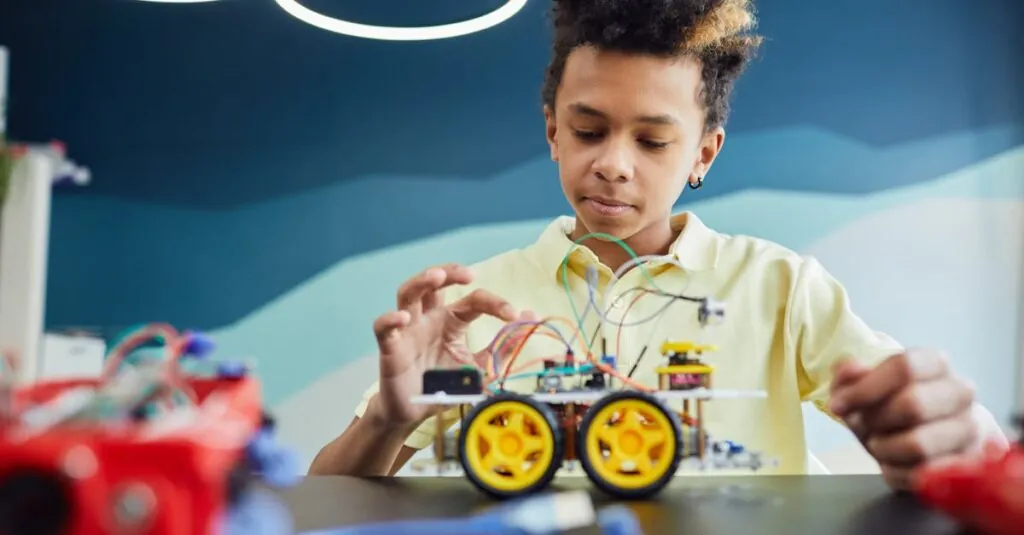Table of Contents
ToggleImagine walking into a classroom where the chalkboard’s been replaced by a smart screen, and the teacher’s assistant is a friendly AI that never runs out of patience. AI in classrooms isn’t just a futuristic fantasy; it’s rapidly becoming a reality. With its ability to personalize learning experiences and provide instant feedback, AI is transforming the way students absorb knowledge.
Overview of AI in Classrooms
AI’s integration in classrooms transforms how educators and students interact with learning. This technology adapts to individual learning styles, adding value to traditional education methods.
Definition of AI in Education
AI in education refers to the application of machine learning algorithms to enhance teaching and learning processes. It includes tools that analyze student performance, streamline administrative tasks, and provide personalized content. AI systems generate adaptive learning experiences that cater to diverse learning needs. These systems can identify areas where students struggle and recommend targeted resources. Additionally, AI fosters student engagement through interactive learning platforms, improving overall educational outcomes.
Importance of AI in Modern Learning
AI’s significance in modern learning lies in its ability to personalize education. Customization helps account for differences in student pace and comprehension levels. By offering tailored feedback, AI addresses individual skill gaps directly. Teachers benefit from AI’s data-driven insights, allowing them to adjust curricula based on student performance metrics. High-quality resources, enabled by AI technologies, promote student motivation and participation. With AI, educational institutions can foster an inclusive learning environment that caters to all students.
Benefits of AI in Classrooms
AI’s impact on education extends beyond simple enhancements, offering significant advantages in personalized learning and administrative efficiency.
Personalized Learning Experiences
Personalization becomes a central focus in AI-driven classrooms. AI technology tailors educational content to meet individual student needs and preferences. Students receive lessons aligned with their learning styles and progress levels. Immediate feedback through AI platforms helps learners understand their strengths and weaknesses more clearly. These insights allow educators to customize lesson plans and resources, improving students’ engagement and retention rates. Learning paths adapt based on performance, ensuring every student receives the appropriate level of challenge.
Administrative Efficiency
AI streamlines administrative tasks for educators, allowing them to focus on teaching. Automating routine tasks like grading frees up valuable time. AI tools provide accurate analytics regarding student performance, which simplifies reporting and communication with parents. Data-driven insights enable teachers to make informed decisions about curriculum adjustments and resource allocation. Scheduling and resource management become less cumbersome, promoting a smoother operational flow within educational institutions. Overall, AI enhances productivity, giving educators more time to engage with students directly.
Challenges and Concerns
AI’s integration into classrooms brings several challenges that educators and administrators must address.
Data Privacy Issues
Data privacy concerns arise with the use of AI in education. Educators collect vast amounts of student data to tailor personalized experiences. Protecting this sensitive information is critical, as breaches can lead to unauthorized access and misuse. Parents and students often question how data is stored and who has access to it, creating discomfort around AI systems. Compliance with regulations, such as FERPA, becomes essential for schools to maintain trust among families. Maintaining a transparent data use policy fosters confidence and ensures ethical practice within the education system.
Equity and Access Considerations
Equity in access remains a significant concern with AI tools in classrooms. Not all students have equal access to technology and high-speed internet, which can create disparities in learning opportunities. Schools in underserved communities often face challenges affording modern AI resources, widening the educational gap. Implementing strategies that promote equitable access is necessary to provide all students with the benefits of AI-enhanced learning. Stakeholders must prioritize funding and support for underprivileged schools, ensuring every student has the chance to thrive in a technology-driven educational environment.
Case Studies of AI Implementation
AI is making profound changes in classrooms. Schools around the world are adopting innovative AI technologies to enhance learning experiences and improve educational outcomes.
Success Stories
One noteworthy example comes from a school district in Georgia. The district implemented an AI-driven tutor that provides personalized support to students in math. This system analyzes student performance, identifies learning gaps, and adapitates instructions accordingly. As a result, students showed a 40% improvement in their test scores after one semester. Another successful application took place in a Philadelphia high school where AI-assisted platforms offered real-time feedback during writing assignments. This helped students refine their skills, leading to higher engagement and better writing proficiency.
Lessons Learned
Challenges during AI implementation have offered valuable insights. Several educators discovered that tailored professional development is critical for teachers. Understanding how to integrate AI tools effectively can enhance their teaching methods and ensure seamless adoption in the classroom. Additionally, addressing data privacy concerns remains vital. Schools learned that establishing transparent policies fosters trust among students and parents. Equitable access to technology became another focal point, highlighting that targeted investments in infrastructure are necessary to avoid widening the digital divide among students.
Future of AI in Classrooms
AI technology continues to evolve, influencing education in dynamic ways. Understanding these developments aids educators and institutions in leveraging AI effectively.
Emerging Trends
Adaptive learning platforms gain traction, tailoring lessons based on each student’s progress. Chatbots provide real-time assistance, ensuring students receive immediate help with questions or concerns. Additionally, analytics tools offer data-driven insights, enabling teachers to identify areas where students struggle the most. Personalized learning experiences become standard, with AI systems suggesting resources specifically designed to meet individual learning preferences. Global use of VR and AR technologies enhances engagement by immersing students in interactive lessons that break traditional learning barriers. These trends illustrate how AI increasingly personalizes and enriches the educational landscape.
Potential Impact on Teaching
AI integration reshapes teaching methodologies. Educators find themselves shifting from traditional lecturing to more facilitative roles, focusing on guiding discussions and fostering critical thinking. Time-saving tools automate grading and administrative tasks, allowing teachers to devote more attention to student interactions. Moreover, AI-driven insights empower instructors to adapt their teaching strategies based on real-time data about student performance. Collaborative learning environments emerge, as AI facilitates group projects tailored to enhance peer interactions. Ultimately, AI’s potential impact on teaching lies in promoting engaging and inclusive learning experiences that prioritize individual needs and encourage collective learning.
AI’s presence in classrooms is reshaping the educational experience for both students and teachers. By personalizing learning and providing immediate feedback, it fosters a more engaging and effective environment. The shift from traditional methods to AI-driven tools highlights the potential for improved student outcomes and enhanced teacher productivity.
However, challenges like data privacy and access equity must be addressed to ensure all students benefit from these advancements. As schools continue to adopt AI technologies, the focus should remain on creating inclusive and supportive learning environments. Embracing these innovations will pave the way for a future where education is tailored to meet the diverse needs of every learner.




